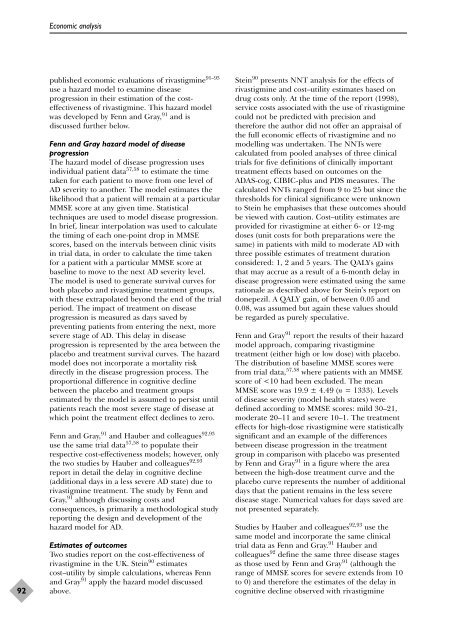Donepezil, rivastigmine, galantamine and memantine for ...
Donepezil, rivastigmine, galantamine and memantine for ...
Donepezil, rivastigmine, galantamine and memantine for ...
Create successful ePaper yourself
Turn your PDF publications into a flip-book with our unique Google optimized e-Paper software.
92<br />
Economic analysis<br />
published economic evaluations of <strong>rivastigmine</strong> 91–93<br />
use a hazard model to examine disease<br />
progression in their estimation of the costeffectiveness<br />
of <strong>rivastigmine</strong>. This hazard model<br />
was developed by Fenn <strong>and</strong> Gray, 91 <strong>and</strong> is<br />
discussed further below.<br />
Fenn <strong>and</strong> Gray hazard model of disease<br />
progression<br />
The hazard model of disease progression uses<br />
individual patient data 57,58 to estimate the time<br />
taken <strong>for</strong> each patient to move from one level of<br />
AD severity to another. The model estimates the<br />
likelihood that a patient will remain at a particular<br />
MMSE score at any given time. Statistical<br />
techniques are used to model disease progression.<br />
In brief, linear interpolation was used to calculate<br />
the timing of each one-point drop in MMSE<br />
scores, based on the intervals between clinic visits<br />
in trial data, in order to calculate the time taken<br />
<strong>for</strong> a patient with a particular MMSE score at<br />
baseline to move to the next AD severity level.<br />
The model is used to generate survival curves <strong>for</strong><br />
both placebo <strong>and</strong> <strong>rivastigmine</strong> treatment groups,<br />
with these extrapolated beyond the end of the trial<br />
period. The impact of treatment on disease<br />
progression is measured as days saved by<br />
preventing patients from entering the next, more<br />
severe stage of AD. This delay in disease<br />
progression is represented by the area between the<br />
placebo <strong>and</strong> treatment survival curves. The hazard<br />
model does not incorporate a mortality risk<br />
directly in the disease progression process. The<br />
proportional difference in cognitive decline<br />
between the placebo <strong>and</strong> treatment groups<br />
estimated by the model is assumed to persist until<br />
patients reach the most severe stage of disease at<br />
which point the treatment effect declines to zero.<br />
Fenn <strong>and</strong> Gray, 91 <strong>and</strong> Hauber <strong>and</strong> colleagues 92,93<br />
use the same trial data 57,58 to populate their<br />
respective cost-effectiveness models; however, only<br />
the two studies by Hauber <strong>and</strong> colleagues 92,93<br />
report in detail the delay in cognitive decline<br />
(additional days in a less severe AD state) due to<br />
<strong>rivastigmine</strong> treatment. The study by Fenn <strong>and</strong><br />
Gray, 91 although discussing costs <strong>and</strong><br />
consequences, is primarily a methodological study<br />
reporting the design <strong>and</strong> development of the<br />
hazard model <strong>for</strong> AD.<br />
Estimates of outcomes<br />
Two studies report on the cost-effectiveness of<br />
<strong>rivastigmine</strong> in the UK. Stein 90 estimates<br />
cost–utility by simple calculations, whereas Fenn<br />
<strong>and</strong> Gray 91 apply the hazard model discussed<br />
above.<br />
Stein 90 presents NNT analysis <strong>for</strong> the effects of<br />
<strong>rivastigmine</strong> <strong>and</strong> cost–utility estimates based on<br />
drug costs only. At the time of the report (1998),<br />
service costs associated with the use of <strong>rivastigmine</strong><br />
could not be predicted with precision <strong>and</strong><br />
there<strong>for</strong>e the author did not offer an appraisal of<br />
the full economic effects of <strong>rivastigmine</strong> <strong>and</strong> no<br />
modelling was undertaken. The NNTs were<br />
calculated from pooled analyses of three clinical<br />
trials <strong>for</strong> five definitions of clinically important<br />
treatment effects based on outcomes on the<br />
ADAS-cog, CIBIC-plus <strong>and</strong> PDS measures. The<br />
calculated NNTs ranged from 9 to 25 but since the<br />
thresholds <strong>for</strong> clinical significance were unknown<br />
to Stein he emphasises that these outcomes should<br />
be viewed with caution. Cost–utility estimates are<br />
provided <strong>for</strong> <strong>rivastigmine</strong> at either 6- or 12-mg<br />
doses (unit costs <strong>for</strong> both preparations were the<br />
same) in patients with mild to moderate AD with<br />
three possible estimates of treatment duration<br />
considered: 1, 2 <strong>and</strong> 5 years. The QALYs gains<br />
that may accrue as a result of a 6-month delay in<br />
disease progression were estimated using the same<br />
rationale as described above <strong>for</strong> Stein’s report on<br />
donepezil. A QALY gain, of between 0.05 <strong>and</strong><br />
0.08, was assumed but again these values should<br />
be regarded as purely speculative.<br />
Fenn <strong>and</strong> Gray 91 report the results of their hazard<br />
model approach, comparing <strong>rivastigmine</strong><br />
treatment (either high or low dose) with placebo.<br />
The distribution of baseline MMSE scores were<br />
from trial data, 57,58 where patients with an MMSE<br />
score of
















